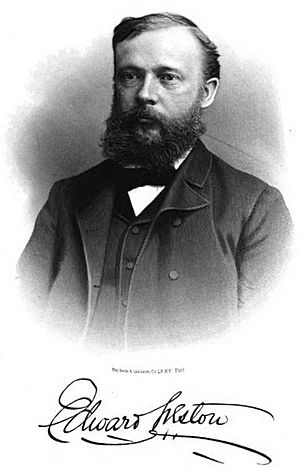Edward Weston (chemist) facts for kids
Quick facts for kids
Edward Weston
|
|
|---|---|
 |
|
| Born | May 9, 1850 |
| Died | August 20, 1936 |
| Occupation | Chemist Electrical engineer |
| Known for | Weston cell |
| Awards | Elliott Cresson Medal (1910) Franklin Medal (1924) |
Edward Weston (born May 9, 1850 – died August 20, 1936) was a brilliant inventor. He was born in England but became an American citizen. He was known for his amazing work with electricity.
Weston made big improvements in a process called electroplating. This is like giving metal objects a thin coating of another metal. He also created a special battery called the Weston cell. This battery was so good it became a worldwide standard for measuring voltage. He even competed with famous inventor Thomas Edison in the early days of electricity.
Contents
Edward Weston's Life and Discoveries
Edward Weston was born in Oswestry, England, in 1850. His family were merchants. He first studied medicine, but he soon became very interested in chemistry. After finishing his medical studies in 1870, he moved to the United States.
He found a job in the electroplating industry. He quickly noticed that they needed a steady supply of electricity. This led him to invent many dynamos and generators. These machines create electric power.
Starting New Companies
Weston helped start the Weston Electric Light Company in Newark, New Jersey. His company even got the job to light up the famous Brooklyn Bridge. He also helped create the New Jersey Institute of Technology. Some of his inventions are still kept there today.
Weston was also the president of the American Institute of Electrical Engineers from 1888 to 1889. This shows how important he was in the world of electricity.
Amazing Inventions
Edward Weston invented two special metal mixtures, called alloys. They are named constantan and manganin. These alloys are still used today in many electrical devices.
He also created the basic designs for many important measurement instruments. These include the voltmeter, which measures voltage. He also invented the ammeter for current and the wattmeter for power. These tools are super important for anyone working with electricity.
In 1888, he started the Weston Electrical Instrument Corporation. This company became famous for making high-quality measuring tools. They made voltmeters, ammeters, and many other devices. Weston also found a way to make "true" permanent magnets. He even invented a magnetic speedometer for cars and a dashboard ammeter for Harley-Davidson motorcycles.
The Weston Cell
One of Weston's most famous inventions was the Weston cell. He patented this special battery in 1893. It's a wet-chemical cell. It uses a mix of cadmium and mercury on one side. Pure mercury is on the other side. A liquid called electrolyte (cadmium sulphate solution) connects them.
The Weston cell produces a very steady voltage. This made it perfect for laboratories to check if their voltmeters were accurate. In 1911, the Weston cell became the International Standard for EMF (which means electromotive force, or the "push" of electricity). Edward Weston was so generous that he gave up his patent rights. This meant anyone could use his invention freely.
Edward Weston passed away in Montclair, New Jersey, in 1936. He received an amazing 309 patents during his lifetime.
Weston's Legacy
Edward Weston's son, Edward Faraday Weston, also became an inventor. He created patents for exposure meters. These devices help photographers figure out the right camera settings. His company, the Weston Electrical Instrument Corporation, made these meters very popular. He also developed the Weston film speed ratings. This system helped measure how sensitive camera film was to light.
Related pages
- Timeline of solar cells

